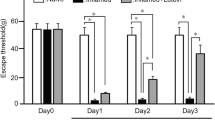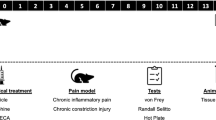Abstract
A long-lasting antihyperalgesic effect has been demonstrated for intrathecal (IT) clonidine, an alpha2-adrenergic agonist. In the present study, the mechanism and antihyperalgesic effects of IT clonidine were examined post-treatment in a rat model of Complete Freund's Adjuvant (CFA)-induced inflammatory hyperalgesia. Using a chronic model of spinal cord dialysis, we examined the effect of the adjuvant-induced inflammation on spinal release of nitric oxide (NO) and the development of chronic pain and assessed the antinociceptive effects and mechanisms of the alpha2-adrenergic agonist, clonidine (IT). Chronic, persistent inflammatory pain was induced by left hind paw injection of 0.3 ml CFA prepared in a mixture with Mycobacterium butyricum. Rats were randomly assigned to groups receiving IT clonidine in discrete doses of 1, 10 or 50 μg, 3 or 24 hr post-inflammation. Measurement of total NO x (NO + \({\text{NO}}_{2 - } + {\text{NO}}_{3 - } \)) was used to determine NO release into the cerebrospinal fluid. Rat thermal antinociception was assessed using a radiant heat thermal hyperalgesia model. CFA injection resulted in significant thermal hyperalgesia throughout the four days of observation. A dose-dependent suppression of thermal hyperalgesia and spinal NO release was observed after IT clonidine treatment. Evidence from this CFA-induced inflammatory pain model suggests that clonidine's spinal antihyperalgesic mechanisms act through inhibition of spinal NO release.
Similar content being viewed by others
REFERENCES
Yang, L. C., M. Marsala, and T. L. Yaksh. 1996. Characterization of time course of spinal amino acids, citrulline and PGE2 release after carrageenan /kaolin-induced knee joint inflammation: a chronic microdialysis study. Pain. 67:345–354.
Sluka, K. A., H. H. Jordan, W. D. Willis, and K. N. Westlund. 1994. Differential effects of N-methyl D-aspartate (NMDA) and non-NMDA receptor antagonists on spinal release of amino acids after development of acute arthritis in rats. Brain Res. 664:77–84.
Yang, L. C., M. Marsala, and T. L. Yaksh. 1996. Effect of spinal kainic acid receptor activation on spinal amino acid and prostaglandin E2 release in rat. Neurosci. 75:453–461.
Davar, G., A. Hama, B. Deykin, R. Vos, and R. Maciewicz. 1991. MK-801 blocks the development of thermal hyperalgesia in a rat model of experimental painful neuropathy. Brain Res. 553:327–330.
Yaksh, T. L., and T. A. Rudy. 1976. Chronic catheterization of spinal subarachnoid space. Physiol. Behav. 17:1031–1036.
Yaksh, T. L. 1989. Behavior and autonomic correlates of the tacitile evoked allodynia produced by spinal glycine inhibition: effects of modulatory receptor systems and excitatoy amino acid antagonists.Pain. 37:111–123.
Eisenach, J. C., M. De Kock, and W. Klimscha. 1996. Alpha sub 2-Adrenergic Agonists for Regional Anesthesia: A Clinical Review of Clonidine (1984-1995). Anesthesiology. 85:655–674.
Yamamoto, T., and N. Shimoyama. 1995. Role of nitric oxide in the development of thermal hyperalgesia induced by sciatic nerve constriction injury in the rat. Anesthesiology. 82:1266–1273.
Zhang, X., V. Verge, Z. Wiesenfeld-Hallin, G. Ju, D. Bredt, S. H. Synder, and T. Hokfelt. 1993. Nitric oxide synthase-like immunoreactive in lumbar dorsal root ganglia and spinal cord of rat and monkey and effect of peripheral axotomy. J. Comp. Neurol. 335:563–575.
Wong, C. S., C. H. Cherng, and C. S. Tung. 1998. Intrathecal adminstration of excitatory amino acid receptor antagonists or nitric oxide synthase inhibitor reduced autotomy behavior in rats.Anesth. Analg. 87:605–608.
Pan, H. L., R. Chen, J. C. Eisenach. 1998. Role of spinal NO in antiallodynic effect of intrathecal clonidine in neuropathic rats. Anesthesiology. 89:1518-23.
Meller, S. T., C. Dykstra, and G. F. Gebhart. 1992. Production of endogeneous nitric oxide and activation of soluble guanylate cyclase are required for N-methyl-D-aspartate produced facilitation of the nociceptive tail-flick reflex. Eur. J. Pharmacol. 214:3-96
Meller, S. T., P. S., Pechman, G. F. Gebhart, and T. L. Maves. 1990.Nitric oxide-mediates thermal hyperalgesia produced in a model of neuropathic pain in the rat. Neuroscience. 50:7–10.
Kitto, K. F., Haley, J. E. and G. L. Wilcox. 1992. Involvement of nitric oxide in spinally mediated hyperalgesia in the mouse.1. Yang, L.C., M. Marsala, and T.L. Yaksh. 1996. Characterization of time course of spinal amino acids, citrulline and PGE2 release after carrageenan /kaolin-induced knee joint inflammation: a chronic microdialysis study. Pain. 67:345–354.
Inoue, T., T. Mashino, S. Shibuta, and I. Yoshiya. 1997. Intrathecal administration of a new nitric oxide donor, NOC-18, produces acute thermal hyperalgesia in the rat. J. Neurol. Sci. 153:1–7.
Fiallos-Estrada, C. E., W. Kummer, B. Mayer, R. Bravo, M. Zimmerman, and T. Herdegen. 1993. Long-lasting increase of nitric oxide synthase immunoreactive, NADPH-diaphorase reaction and c-JUN co-expression in rat dorsal root ganglion neurons following sciatic nerve transection. Neurosci. Lett. 150:169–173.
Mao, J., D. D. Price, and D. J. Mayer. 1995b. Experiment mononeuropathy reduces the antinociceptive effects of morphine: implications for common intraceullar mecanisms involved on morphine tolerance and neuropathic pain. Pain. 61:353–364.
Mayer, D. J., J. Mao, J. Holt, and D. D. Price, 1999. Cellular mechanisms of neuropathic pain, morphine tolerance, and their interactions.PNAS 96:7731–7736.
Moore, P. K., A. O. Oluyomi, R. C. Babbedge, P. Wallace, and S.L. Hart. 1991. L-NG-nitro arginine methyl ester exhibits antinociceptive activity in the mouse. Br. J. Pharmacol. 102: 198–202.
Zimmermann, M. 1983. Ethical guidelines for investigations of experimental pain in conscious animals. Pain. 16:109–110.
Hargreaves, K., R. Dubner, F. Brown, C. Flores and J. Joris. 1988.A new and sensitive method for measuring thermal nociception in cutaneous hyperalgesia. Pain. 32:77–88.
Braman, R. S., S. A. Hendrix. 1989. Nanogram nitrite and nitrate determination in environmental and biological materials by vanadium (III) reduction with chemiluminescence detection. Anal. Chem. 61:2715–2718.
Hao, S., O. Takahata and H. Iwasaki. 2001. Antinociceptive interaction between spinal clonidine and lidocaine in the rat formalin test: an isobolographic analysis.Anesth. Analg. 92:733–738.
Mao, J., D. D. Price, D. J. Mayer, J. Lu, and R. L. Hayes. 1992. Intrathecal MK-801 and local nerve anesthesia synergistically reduce nociceptive behavior in rats with experimental peripheral mononeuropathy. Brain Res. 576:254–262.
Osborne, M. G. and T. J. Coderre. 1999. Effects of intrathecal administration of nitric oxide synthase inhibitors on carrageenaninduced thermal hyperalgesia.Br. J. Pharmacol. 126:1840–1846.
Duarte, I. D. and S. H. Ferreira. 2000. L-NAME causes antinociception by stimulation of the arginine-NO-cGMP pathway. Mediators Inflamm. 9:25–30.
Roche, A. K., M. Cook, G. L. Wilcox and K. C. Kajander. 1996. A nitric oxide synthesis inhibitor (L-NAME) reduces licking behavior and Fos-labeling in the spinal cord of rats during formalininduced inflammation. Pain. 66:331–41.
Lewin, M. R. and E. T. Walters. 1999. Cyclic GMP pathway is critical for inducing long-term sensitization of nociceptive sensory neurons. Nature Neurosci. 2:18–23.
Malmberg, A. B., and T. L. Yaksh. 1995. Cyclooxygenase inhibition and the spinal release of prostaglandin E2 and amino acids evoke by paw formail injection: a microdialysis study in unanesthetized rats.J. Neurosci. 15:1768–2776.
Ishikawa, T., M. Marsala, T. Sakabe, and T. L. Yaksh. 2000. Characterization of spinal amino acid release and touce-evoked allodynia produced by spinal glycine or GABAA receptor antagonist.Neuroscience. 95: 781–786.
Sherman, S. E. and C. W. Loomis. 1995. Strychnine-dependnet allodynia in the urethane-anesthetized rat is segmentally distributed and prevented by intrathecal glycine and betaine. Can. J. Physiol. Pharmacol.. 73:1698–1705.
Simpson, R. K. Jr., M. Gondo, C. S. Robertson, and J. C. Goodman. 1996. Reductin in the mecanonciceptive response by intrathecal administration of glycine and related compounds. Neurochem. Res. 21:1221–1226.
Simpson, R. K. Jr., M. Gondo, C. S. Robertson, and J. C.Goodman. 1997. Reductin in thermal hyperalgesia by intrathecal adminstration of glycine and related compounds. Neurochem. Res. 22:75–79.
Raigorodsky, G. and G. Urca. 1990. Involvement of N-methyl-Daspartate receptors in nociception and motor control in the spinal cord of the mouse: behavior, pharmacological and electrophysiological evidence. Neurosciene. 36:601–610.
Author information
Authors and Affiliations
Rights and permissions
About this article
Cite this article
Lin, CR., Chuang, YC., Cheng, JT. et al. Intrathecal Clonidine Decreases Spinal Nitric Oxide Release in a Rat Model of Complete Freund's Adjuvant Induced Inflammatory Pain. Inflammation 26, 161–166 (2002). https://doi.org/10.1023/A:1016563628274
Issue Date:
DOI: https://doi.org/10.1023/A:1016563628274




